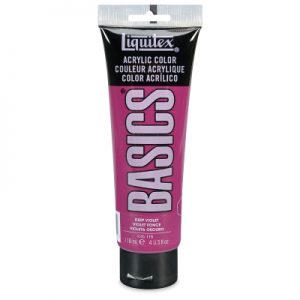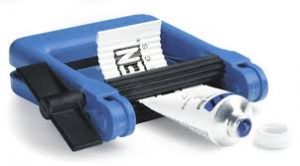You know that saying
“It’s a poor craftsman that blames his tools”
Well it’s not necessarily true. Especially with paint. The ingredients make a big difference in how paint behaves, whether it’s smooth or sticky, how well it spreads around and whether you can mix colors to get something good (or just bleh).
For Paint & Party, I mostly use “Liquitex – Basics” . It’s a very popular brand – in fact, I was reading about a famous cartoonist and saw a tube of Liquitex Basics on his studio table!
I like it because the texture is buttery and not all runny, so it stays where you put it on the canvas. If you want your acrylic paint to be a little more runny so it feels more fluid, you can always water the paint down a bit. That’ll also make your tube of paint last longer (btw – if you have super-hard well water like I do, you might want to use bottled or filtered water for your painting).
It’s also nice when paint is thicker because you can sculpt it and play with the texture as you add more layers.
And the Liquitex Basics colors are pretty intense, so when you mix colors you get interesting browns, instead of mucky greys.

Grumbacher Academy is also a good brand – I think their colors are a little less intense, but some people prefer them.

If you want to go for the top and buy the very best professional-quality acrylic paint, then choose Golden Acrylics

Golden Acrylics have a wonderful texture, and their pigments are very high-quality, so they’re vibrant and strong. The downside of high-quality pigments, though, is they have a higher metal content, so they’re more toxic. You can tell by the tubes themselves – grab a tube of cheap paint and and very pricey paint, and they expensive one will be heavier.
When you’re shopping in the store or online, the choices can be overwhelming! Our Michael’s has at least 4 different brands of acrylics and dozens of colors.
Really you don’t need to buy all the colors, you can just start with five:
Cadmium red hue
Cadmium yellow hue
Cobalt blue
Burnt umber
Titanium white
Pick up some ultramarine blue, violet and magenta if you like. Cerulean blue is nice, too.
There are usually a couple of choices for reds and yellows – you can pick a “deep” or “light” version. Start with whichever one appeals to you.
Generally I recommend staying away from bargain paint. I find that the black isn’t really black, it’s just dark blue. And the red isn’t actually red, it’s more orange. That means when you mix the red with blue, you’ll get more of a brown than a purple. If it’s that or nothing, then of course buy some. Or if spending more makes you self-conscious, then go for cheap. Sometimes it’s easier to experiment and take chances when you didn’t spend a lot on the paint. Just don’t be hard on yourself if your red apple doesn’t really look red, or you can’t mix purple.
And when you get down to that last ounce of paint and it’s just impossible to squeeze it out, there are two tricks. I have one of these squeezers that I use for metal tubes

With plastic tubes, I just cut the end off the tube and dip right in. There’s always enough paint to make at least one painting.






